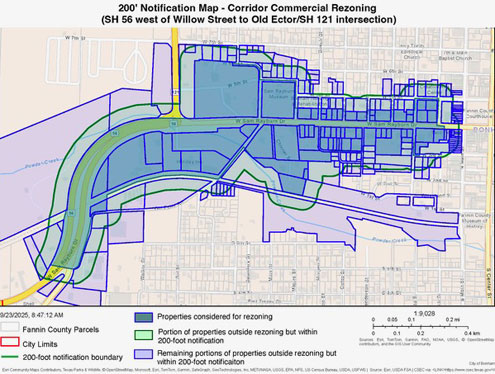OPPOSITION MEMO
Re: Proposed “Corridor Commercial District” / Rezoning Proposal
To: Bonham Planning & Zoning Commission and Bonham City Council
Date: October 16, 2025
Subject: Formal Opposition to Corridor Commercial District and Rezoning of Local Business (LB) Areas
---
I hereby respectfully oppose the City’s proposed adoption of a Corridor Commercial (CC) zoning district and any rezoning of existing Local Business (LB) parcels into that district. The change is procedurally and substantively unsound, inconsistent with Bonham’s adopted planning goals, and poses undue burdens on adjacent residential areas and city infrastructure.

1. Legal & Procedural Concerns
a. Statutory Notice & Protest Rights (Tex. Local Gov’t Code § 211.006):
i. Property owners received notices referencing a zoning district that was not yet in legal effect. The law mandates advance written notice and a public hearing before a zoning amendment. Owners representing at least 20% of the land area in the affected zone or within 200 feet can file a written protest to require a three-fourths (¾) supermajority vote by Council. Failure to strictly comply renders the rezoning vulnerable to legal challenge.
b. Plan Consistency & Arbitrary Rezoning:
i. The City must demonstrate consistency with the Comprehensive Plan / Vision Bonham. “Corridor Commercial” is not identified in Bonham’s adopted plan; the corridor is designated for Local Business / Mixed-Use Transition. Rezoning without showing changed conditions or alignment with the Plan risks being arbitrary or capricious under Texas precedent (see Hunt v. City of San Antonio, Thompson v. City of Palestine).
c. Spot Zoning & Nonconforming Uses:
i. Rezoning select LB parcels may amount to spot zoning—granting special rights to a few parcels that conflict with the surrounding zoning fabric. It also may convert existing conforming uses to nonconforming, imposing burdens on property owners. See legal doctrine on spot zoning as arbitrary special treatment.
2. Substantive & Community Impact Risks
a. Traffic, Safety & Infrastructure Strain:
i. TxDOT AADT data for SH 56 exceeds 10,000‒12,000 vehicles per day, already straining intersections at SH 121 and Center Street. More intense commercial uses generate higher trip volumes, turning movements, and heavy vehicles. The City has not presented a corridor-level traffic study showing intersections can absorb the load. Without infrastructure upgrades, this change may result in congestion, accidents, and excessive maintenance costs.
b. Erosion of Residential Buffers & Quality of Life:
i. Many LB parcels directly abut homes without the 50-foot buffer required by current code. LB zoning currently mandates buffering between commercial and residential uses. Under CC zoning, these protections may be weakened—leading to noise, light, traffic ingress/egress, and visual intrusions into neighborhoods.
c. Property Value Risk:
i. Spot upzoning introduces uncertainty for existing residents and small business owners.
d. Fiscal Risk to City:
i. Any increased tax revenue from commercial expansion may be offset over time by higher costs for road maintenance, drainage, policing, utilities, and capital upgrades.
e. Conflict with Vision Bonham Goals:
i. The Vision Bonham 2017–2025 plan emphasizes safe neighborhoods, orderly growth, and infrastructure planning in line with projected population and development. Rezoning parcel by parcel to Corridor Commercial undermines that deliberate vision.
3. Requested Actions & Conditions
a. Deny or Table the proposal until Corridor Commercial district text is published and reviewed. Along with proper studies, notices, and public input are in place.
b. Require a full traffic/infrastructure impact analysis, including peak hour and turning movement studies, before approving any commercial intensification.
c. Require site plan review for any CC uses adjoining residential zones
d. Preserve LB zoning as the base district and use an overlay for corridor standards.
e. Split the hearing process: first to adopt a new zoning district text, and separately (with proper notice) to consider rezoning individual parcels.
f. Favor conditional overlays or use restrictions (e.g. no heavy trucks, limited hours, enhanced buffer requirements) rather than blanket rezoning.
g. Engage affected property owners in a community workshop to explore alternatives that respect residential buffering while allowing measured growth.
h. Reissue notices under §211.006 with accurate zoning descriptions to all affected owners.
This proposal threatens to erode the intentional balance between neighborhood-level commercial convenience and residential livability. I urge you to reject, postpone, or substantially condition the adoption of the Corridor Commercial District and any LB→CC rezoning at this time.
Respectfully submitted,
Jade Custer
For more information, contact Jade Custer at custerjs@gmail.com or 402-960-6901.


